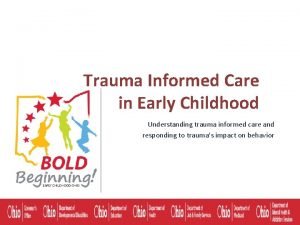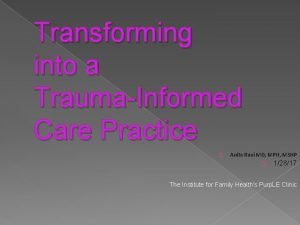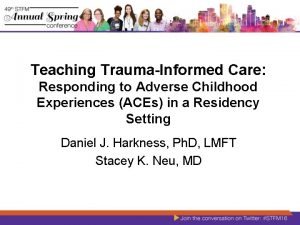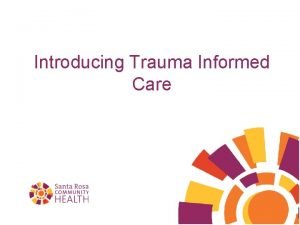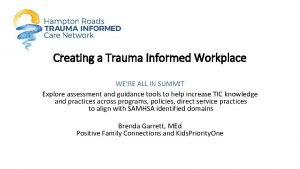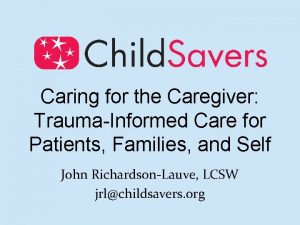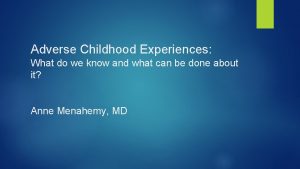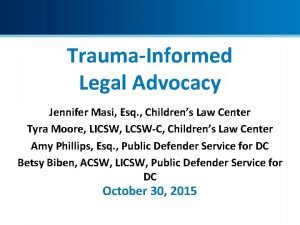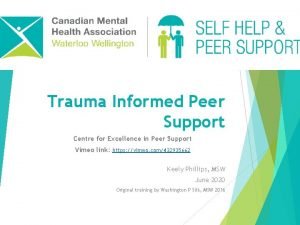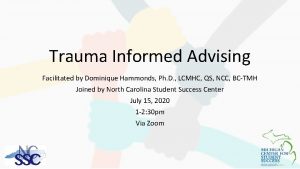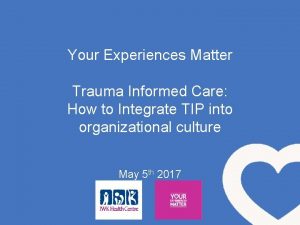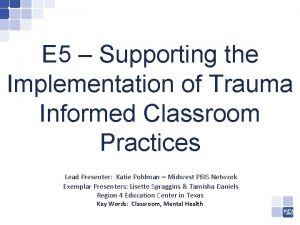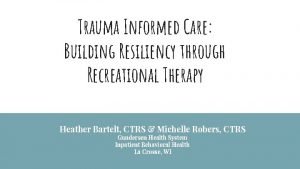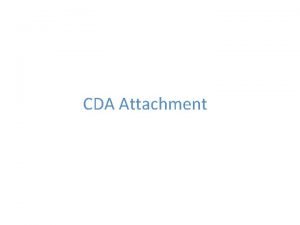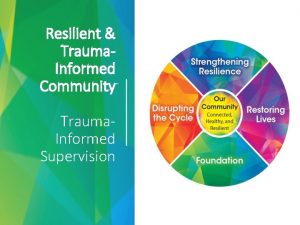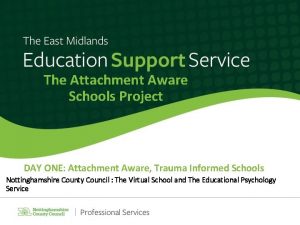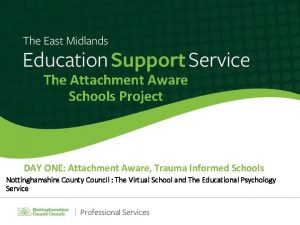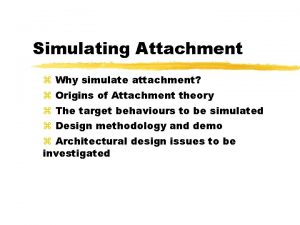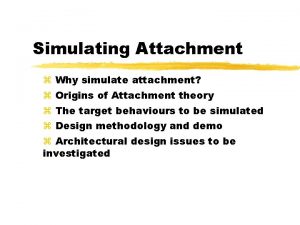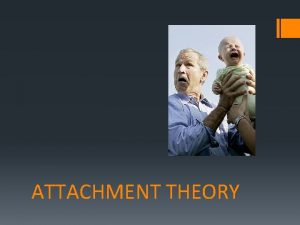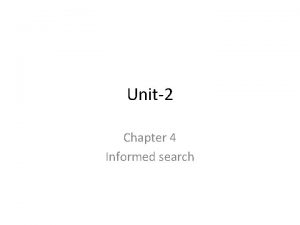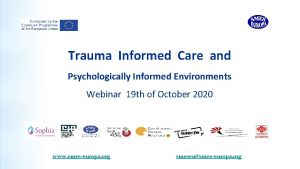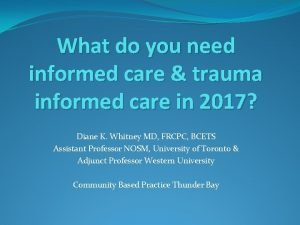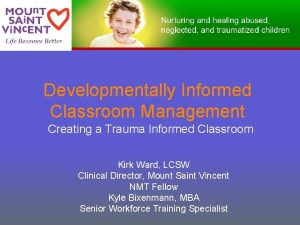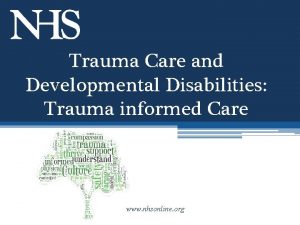The Attachment Aware and Trauma Informed School Supporting
















- Slides: 16

The Attachment Aware and Trauma Informed School ‘Supporting Vulnerable Pupils’ By Lelia Berkeley Headteacher, SENCO and Attachment Lead (Attachment Lead Network- Michelle Bomber)

St Andrew’s CE Primary School, Marks Tey ETHOS AND CULTURE ‘Relationships Matter’ ‘We can and we do make a difference’ “We aim to be an outstanding school providing excellent and inspiring teaching in a stimulating and creative environment, enabling all children to achieve their personal best and be ready for their next steps, by placing the child at the centre of everything that we do. ” • Small things (greeting in the morning, knowing the child’s interests, special days, sad days etc. ) • Inclusiveness • Child Centred Practice (curriculum and all additional provision starts with the unique child – informs policy and shapes culture) • Whole school are Attachment aware and Trauma Informed (not just formal training but informal discussions shaping culture). Communication is key- conversations that promote the practice in the school and acknowledge the importance of understanding the child’s developmental journey to date –drip feed • Modelling by leaders – understanding, empathy, compassion, humour whilst maintaining boundaries and boundaries ‘okay to be you’ ‘okay to try out new things’- acceptance • Increasing staff care increases care giving capacity. Staff well-being of key importance.

The AATI School - CORE BELIEFS UNDERSTANDING Relational loss and trauma are adverse childhood experiences which disrupt and impact on a child’s emotional development and capacity for learning. What have they lived? Where is the trauma now? HOPE We can provide the stepping stones necessary towards adaptation and recovery so that these pupils learn security and self-regulation. What can we give them that they haven’t had? TRUST As Education Staff we can become both the eyes and minds for the pupil, and the external stress regulators they need at this stage. Dependency provides safety, security, stability and repetitive attentive, attuned responses LOVE / EMPATHY /HUMANITY Building strong ‘relational bonds’ is key. Relationships are the bridge into adaptation and recovery

Circle of Security https: //www. youtube. com/watch? v=1 wpz 8 m 0 BFM 8

Attachment Aware • Attachment is a relational bond. The bond serves 2 functions; a protective function and an exploratory function. The protective function is intended to keep the small, weak, defenceless, vulnerable child close to a grown-up using proximity seeking behaviours. The exploratory function is intended to allow the grown up to serve as a safe base from which to go off and explore. • As children we lay down templates( an internal working model) for how the world works. This includes how we feel about ourselves, how we feel about other people, how we feel about the world. If we’ve had attachment to adults who’ve attuned to our needs, empathised with our feelings and emotional states, and who’ve been reliable, consistent, and able to readily repair the relationship with us when things go wrong, our template will be secure and positive. • Toxic stress can interfere with the bonding experience. If a child grows up experiencing relational traumas and losses , or parental addiction, domestic violence, different kinds of abuse, neglect…she or he may develop insecure patterns of attachment, and grow up feeling negatively about themselves, about other people, and about the world. • The child’s behaviour may communicate their pressing need to survive in what they experience as a hostile world; even when immediate threat is no longer present. It is these children that we want to help in an attachment aware way.

Attachment Aware • Internal working models of relationships - Faulty internal working models : child blocks trust, feels shame, miscues behaviours of others- seeks evidence to fit internal working model – adults can’t be relied on. ‘What pupil has lived through will often be played out in their bodies. Their body, heart and mind carry the story and the evidence. ’ (Louise Bomber) • Awareness of Attachment Styles – avoidant / ambivalent / disorganised where possible to establish. These internalised working models help pupils adapt and survive when there was a threat however their approach now compromises their well-being, functioning and capacities (Kim’s Flowers) • FACTFILE / TRAUMA PATHWAY for child – understanding of extraordinary stressors / developmental trauma and toxic stress; hypervigilance, high anxiety, stress responses, attention seeking, control battles, poor immune system, pseudo-independent • • Emotional age of the child – observation checklist- awareness of stressors and calmers /sensory intervention • Validating the child’s experience ‘It is a big ask for you to trust grown ups when adults have let you down in the past. ’ Thank you! (Brave to be vulnerable – Language of ‘Big Feelings. ’ • Stress regulation v behaviour management (TASK – Attachment Aware vs Behavioural Approach) Faulty Alarm System – ‘I’m not okay, you’re not okay, the world is unsafe. ’ Nervous system is confused. Experiences are overwhelming, terrifying, unpredictable, feel powerless, abandoned, high levels of cortisol. (FIGHT FLIGHT, FREEZE, FALL) Impacts on brain development

TRAUMA INFORMED ‘Know the developmental stage and watch the state’ of the troubled children in your care. RESPECT BIOLOGY • FACTFILE for vulnerable pupil - Understanding of the impact of experiencing significant relational trauma and loss • Awareness of state dependent behaviour – Possible states CALM- ALERT-ALARM-FEAR-TERROR Dr Daniel Siegel ‘s Hand Model of the brain https: //www. youtube. com/watch? v=f-m 2 Ycd. Md. Fw https: //www. youtube. com/watch? v=5 Cp. RY 9 -MIHA • For children to be able to take in what we are saying or ‘to learn, ’ they need to be in a calm or alert state. Most of our school interventions are based on this premise. Troubled pupils spend most of their time in the alarm state, not hearing 40%+ of the cognitive content being presented, falling behind. These same pupils also move very quickly into fear and terror at different points during the school day. • ‘Know the developmental stage and WATCH the state’ Dr Bruce Perry Social and Emotional Development in Early Childhood https: //www. youtube. com/watch? v=vk. Jw. FRAw. DNE

Updating our practice in line with neuroscience to ensure inclusion at every level Neurosequential model Dr Bruce Perry - Child Trauma Expert - Arousal Continuum CALM ALERT ALARM FEAR TERROR (no reflective capacity) Shift states – emotion regulator Four R’s • REGULATE - Connection first, regulation rich relationship, increase sensory comfort, ‘I can down regulate’ adults can be trusted • RELATE – Connect, ‘lets’ ‘I wonder if’ (mirror neurons) • REASON –Cognitive / Discipline • REPAIR

Intervention • State dependent – i. e. appropriate to use a reassuring touch if a pupil was starting to move into an alarm state but it would be inappropriate to use touch in the same way if the pupil was in the terror state • Keep watching the state of the pupil as this will inform the type of intervention used • Rhythmic patterns support functioning. Thinking carefully about how to include tapping, walking, gentle movement, dance, drumming, music into lessons. Dr Bruce Perry recommends integrating rhythm in small doses throughout the school day. • Sensory breaks enable the lower part of the brain to be soothed, freeing up the higher parts- the thinking cortex- to come online and work optimally. Number and type linked to child’s needs – helpful for all troubled pupils but especially the ones who become more hyperactive in their states moving into fight/flight responses. Use sensory breaks that will enable the pupil to slow down and become grounded. • Safe space for these pupils to have a download time. Sensory break with key adult. Together coregulation happens. Aim to be preventative. • Team Child – assess / review / permanency / whole school approach

Key Adult - Fellow Traveller - Translator ‘Bigger, Stronger, Wiser’ ‘We all learn who we are through the minds and eyes of another, not in isolation’ (reflect back who the child is- challenge internal working model) ‘Every relationship has the power to confirm or challenge all that’s gone before’ (Louise Bomber Touchbase) SECOND CHANCE LEARNING – to experience what you should have experienced first time round (WINNICOTT) INCREASE RICH RELATIONSHIP EXPERIENCES RELATIONSHIPS BRING INTEGRATION OVERCOMPENSATE FOR FRAGILE SENSE OF SELF ADDRESS NEED FOR SECURITY AND STABILITY CHILDREN CAN LEARN SECURITY CHILDREN CAN NEGOTIATE THE NECESSARY DEVELOPMENTAL MILESTONES

Key Adult • Caregiving capacity –Attentive, attuned, responsive (physically and emotionally present) Over compensatory care • Consistent and reliable ‘Quality time for you. ’ Sensory comfort Playful Fun Humour Joy • Co-regulating / co-modelling ‘felt safety’ – free up exploratory system – attend to child’s attachment system – ‘lets’ ‘we’ ‘together’- pupil knows you remain connected and alongside supporting them to repair whatever has gone wrong • Commenting aloud for the child ‘I wonder if…’ Translate for child (distorted lens / regulatory system compromised )- Leads to self regulation • Communication with ‘Team Child’ (small tight team believing in and rooting for the pupil / small family unit in big system in school – child can internalise key people /facilitates permanency ) ‘Having several good attachment relationships predicts better self-control, behaviour and relationships. ’ (Besky et al 2007) • Therapeutic tools (Mountain, blob pictures, sensory box, jar of strengths, parts picture, Theraplay) CASE STUDY – Presentation from Well-being mentor / Key adult at St Andrew’s

The Power of the Relationship For: Developing a sensory literacy Developing empathy Making sense of… Expressing needs appropriately Developing an emotional literacy Organising thought Communicating clearly Mentalisation / reflective function Wondering aloud is a very helpful technique that can be a concrete expression of giving the child an experience of ‘being attended to. ’ The key adult makes tentative remarks about what she thinks is happening for the child. ‘I’m wondering if…. . ’ The adult attempts to put into words what might be going on inside the child. Commentaries Commentating is a technique in which the key adult makes concrete comments about what is happening for the child both internally or externally, or both based on her direct observations in the moment, gleaned from experience with and from the child, or from information about his past history. (the adult needs to have invested considerable quality time getting to know the child first) (Louise Bomber 2007)

PACE The Principles of PACE impacting on communication Working out together more effective ways for the child to understand, make sense of and manage their emotions, thoughts and behaviour • P Playfulness – An atmosphere of lightness and interest when you communicate • A Acceptance – Unconditional acceptance is at the core of a child’s sense of safety • C Curiosity – Curiosity, without judgement, is how we help children become aware of their inner life Curiosity is wondering about the meaning behind the behaviour for the child. Curiosity lets the child know that the adults understand. • E Empathy – Sensitivity of response / Empathy lets the child feel the adult’s compassion for him/her. Dr Bruce Perry Born for Love: Why Empathy is essential and endangered https: //www. youtube. com/watch? v=5 g. U 1 w. Xbs 5 mc&safe=active

THERAPLAY Theraplay® as a way of ‘being together with the pupil. ’ Activities to support connection and to have fun with the child in 1: 1 sessions. There is increased eye contact, fun playful interaction supporting the attachment bond. It supports nurturing touch in a boundaried way and developments the richness of the relationship, creating positive memories along the way. It supports the notion of the safe space for the child as theraplay activities will be non-intrusive helping to support the building of a trusting relationship. • • STRUCTURE - KEY CONCEPTS: SAFETY, ORGANISATION, REGULATION NURTURE - KEY CONCEPTS: JOY OF COMPANIONSHIP, ATTUNEMENT, NOW MOMENTS ENGAGEMENT – KEY CONCEPTS: SECURITY, SELF-WORTH, STRESS REDUCTION CHALLENGE – KEY CONCEPTS: COMPETENCE, MASTERY, PLAY

Case Study – Celebrating success The impact of Therapeutic ways of working with children Growing in the context of a healthy, safe relationship

‘Helping you to reach your destination’ ‘Thank you for being a willing and trusting passenger on Mrs Berkeley’s Airways…there is always a reserved seat (in first class…with complementary ripples and moose story books) for YOU!’ ‘Accepting and empathic others can be like mirrors revealing things to us that we may not have even noticed before, nudging us out from places where we may have got stuck, urging us into healthier ways of being and relating. ’ (Brene Brown 2012)
 4 r's trauma informed care
4 r's trauma informed care Lgbtq trauma informed care
Lgbtq trauma informed care Dr anita ravi
Dr anita ravi Trauma-informed care cheat sheet
Trauma-informed care cheat sheet Trauma-informed care activities for staff
Trauma-informed care activities for staff Trauma-informed workplace checklist
Trauma-informed workplace checklist Trauma-informed questions for clients
Trauma-informed questions for clients 4 r's trauma informed care
4 r's trauma informed care Trauma informed legal advocacy
Trauma informed legal advocacy Trauma informed peer support
Trauma informed peer support Libby bergman
Libby bergman Tina champagne trauma informed care
Tina champagne trauma informed care Trauma informed advising
Trauma informed advising Trauma informed parenting discipline
Trauma informed parenting discipline Trauma informed practice
Trauma informed practice Trauma informed physical environment
Trauma informed physical environment Trauma-informed care cheat sheet
Trauma-informed care cheat sheet
